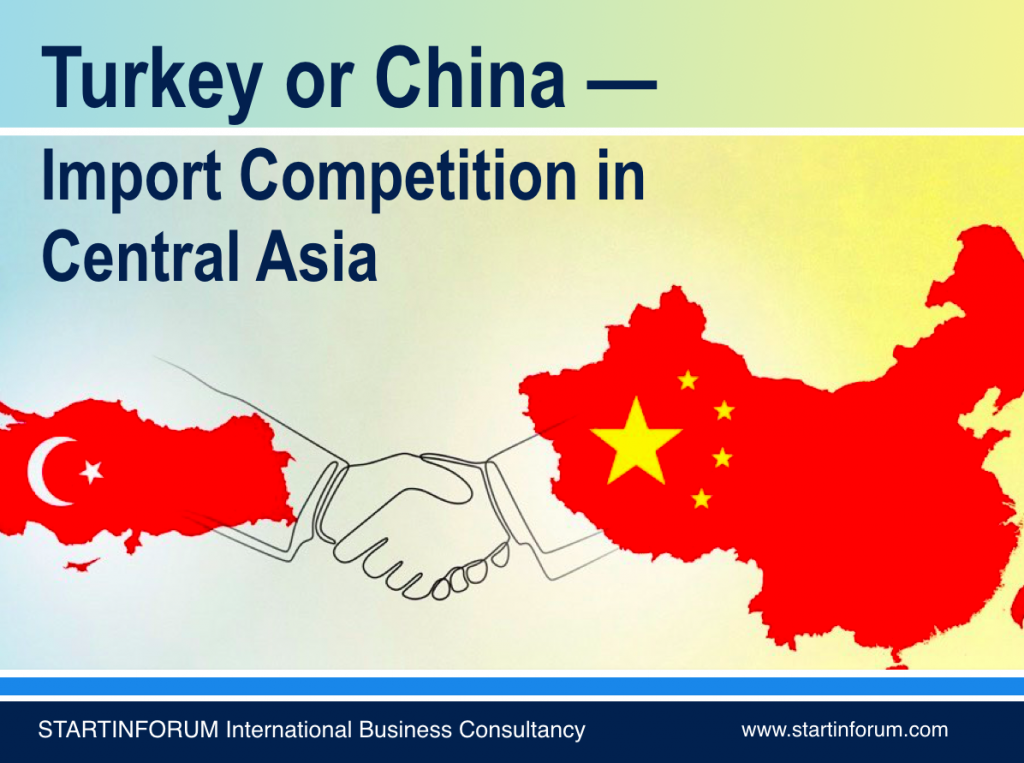Competing with China in Central Asia is a significant challenge for Turkish goods, given China’s massive production capacity, aggressive pricing, and extensive Belt and Road Initiative (BRI) infrastructure investments.
However, Turkey possesses several inherent advantages that it can leverage to effectively compete.

Diplomatic relations between the Republic of Turkey and the People’s Republic of China (PRC) were established in 1971.
Bilateral relations have been progressing steadily since the 1980s with the opening-up of both countries.
1. Quality Perception and Brand Image
- Turkish Advantage: In many product categories, Turkish goods are perceived to have higher quality, better design, and adhere to more stringent European standards compared to mass-produced Chinese goods. This is particularly true for textiles, apparel, certain machinery, home appliances, and food products. Consumers in Central Asia, as their purchasing power increases, are often willing to pay a premium for higher quality and durability.
- Chinese Challenge: While China offers a vast range of products at various quality levels, the general perception in many markets, including Central Asia, can still lean towards lower quality for the cheapest Chinese imports.
- Strategy for Turkey: Emphasize “Made in Turkey” as a mark of quality, reliability, and modern design. Invest in branding, marketing, and after-sales service to reinforce this image. Target segments that prioritize quality over just the lowest price.
2. Geographic Proximity and Logistics (Middle Corridor)
- Turkish Advantage: Turkey is geographically closer to Central Asia than China. While not directly bordering, Turkey is actively developing the “Middle Corridor” (Trans-Caspian International Transport Route) that connects Europe and China via Turkey, the Caucasus, and the Caspian Sea. This route significantly reduces transit times compared to traditional sea routes (e.g., 10-15 days vs. 35-45 days). This means faster delivery, reduced inventory costs, and quicker response to market changes for Turkish goods.
- Chinese Challenge: While China has massive investments in land routes through Central Asia via BRI, the sheer distance and potential for bottlenecks at various borders can still make overall transit times long for certain goods, especially those destined for the western parts of Central Asia.
- Strategy for Turkey: Continuously invest in and promote the Middle Corridor. Improve customs procedures and border crossings. Offer integrated logistics solutions that highlight faster and more efficient delivery times. This advantage is particularly strong for time-sensitive goods.
3. Cultural and Historical Ties (Soft Power)
- Turkish Advantage: Turkey shares deep historical, linguistic, and cultural ties with the Turkic-speaking Central Asian republics (Kazakhstan, Uzbekistan, Kyrgyzstan, Turkmenistan). This fosters a natural affinity for Turkish products and a sense of trust. Turkish TV series, music, and educational programs are popular, subtly building brand recognition and preference. The Organization of Turkic States (OTS), led by Turkey, further strengthens these bonds.
- Chinese Challenge: While China offers economic benefits, its cultural influence in Central Asia is less profound compared to Turkey’s.
- Strategy for Turkey: Leverage this soft power. Participate in cultural events, establish educational exchange programs, and promote shared heritage. This can translate into stronger consumer loyalty and business relationships.
4. Flexibility and Adaptability
- Turkish Advantage: Turkish manufacturers are often more flexible in terms of order sizes, customization, and adapting to specific market demands. They can offer quicker design changes and smaller batch production compared to large Chinese factories. This is particularly beneficial for niche markets or evolving consumer trends. Turkish companies are also known for flexible payment terms.
- Chinese Challenge: While China offers immense scale, large Chinese manufacturers might be less flexible for smaller, customized orders.
- Strategy for Turkey: Highlight agility and responsiveness to market needs. Offer tailored solutions and quicker lead times.
5. After-Sales Service and Support
- Turkish Advantage: Due to geographical proximity and a more similar business culture, Turkish companies can often provide better after-sales service, technical support, and warranty provisions. This is crucial for complex machinery and electronics where long-term reliability and maintenance are important.
- Chinese Challenge: For many low-cost Chinese goods, after-sales support can be limited or difficult to access.
- Strategy for Turkey: Build strong local service networks, offer training, and ensure readily available spare parts. This builds trust and customer loyalty.
6. Diversification from Over-Reliance on China
- Turkish Advantage: Central Asian countries are increasingly looking to diversify their economic partnerships and reduce over-reliance on any single external power, including China. Turkey presents a viable and attractive alternative for imports.
- Strategy for Turkey: Position itself as a reliable, high-quality, and strategically aligned partner that helps Central Asian countries diversify their supply chains.
7. Preferential Trade Agreements and Investment
- Turkish Advantage: Turkey has signed Preferential Trade Agreements (PTAs) with countries like Uzbekistan, significantly reducing tariffs and making Turkish goods more competitive. Turkish direct investments in Central Asia also create a demand for Turkish goods and services within those projects.
- Chinese Challenge: While China offers loans and investments through BRI, the terms can sometimes lead to debt concerns for recipient countries.
- Strategy for Turkey: Promote and expand PTAs. Increase direct investment in local production and infrastructure, which naturally creates a market for Turkish intermediate goods and machinery.
In summary, to effectively compete with China in Central Asia, Turkey should focus on a multi-pronged strategy:
- Leverage its strengths: Emphasize quality, design, brand reputation, and excellent after-sales service.
- Exploit geographical advantages: Promote and utilize the Middle Corridor for faster and more cost-effective logistics.
- Deepen cultural ties: Use soft power to build consumer preference and trust.
- Be flexible and responsive: Offer customized solutions and agile supply chains.
- Capitalize on diversification trends: Position Turkey as a strategic alternative for reliable and high-quality imports.
- Utilize trade agreements and investment: Make Turkish goods more competitive through favorable tariffs and by embedding Turkish products in local projects.
While Chinese goods will always have a price advantage in many basic commodity categories, Turkey can win by targeting higher-value segments, offering better quality, faster delivery, and stronger relationships.